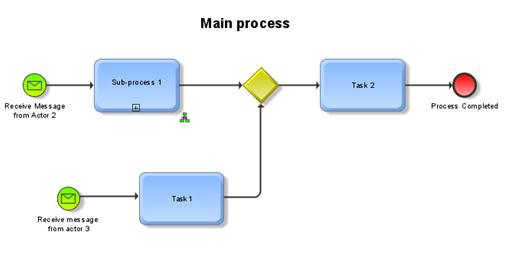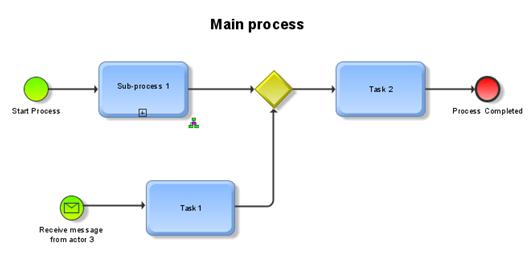Hello Community,
I would like to ask your help to find out solution on modelling proper process start triggers.
Backgroud information: Approach in modelling is that main (overview) model contains main process steps and interaction with other actors and detailed information is in sub-processes (for each sub-process there might be different actors involved).
Example of issue:
Main process start can be triggered by one or other message received from different actors.
1st modelling variant:
So then when we navigate to sub-process 1 (as a separate process), we lose important information as receive of message is left on main process.
2nd variant: to model is that receive of message is modelled in sub-process, which then gives complete information of information exchange.
But then problem that one flow of main process does not have proper start trigger anymore (receive of message).
Or 3rd variant: modelling start receive messages in both, main process and sub-process, but that is not anymore BPMN compliant, I guess ...
What could be other BPMN and/or ARIS solutions to handle this issue with process start triggers in a proper way? To have full information on message exchange in sub-process and at the same time to have proper process start trigger in main (overview) process.
Different modelling style? Or other way to use BPMN notation?
Thank you a lot for any help and advices on this!:)







Ivo Velitchkov on
Ilze,
BPMN does not allow pools or lanes in a Sub-process. And I don't think you can start a Sub-process with a Message Receive Event either. A sub-process is always started by its parent event (untyped start event). It is arguable if it could have another start event. But even those who think it can at least admit that could only be a signal, timer and suchlike but not Message Receive Event. If you can start a sub-process by a Message Receive Event that would mean that you can model an incoming message flow from a partner of the parent. When you assign a process, ARIS allows you to do things that are not compliant but if you try it with embedded sub-process you'll see that you can't and that's a correct method restriction. So it is good to test the content of a sub-process when embedded to be sure about BPMN compliance.
This was only about what is not allowed and nothing about why because it could make the comment quite long to go into this.
In conclusion, the variant 1 - but without pools - seems like the only option.
But I would be interested to hear more opinions on that.